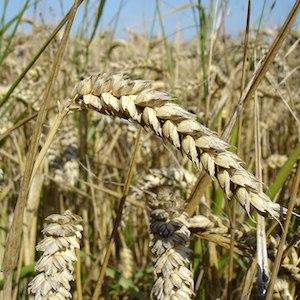By Senay Simsek
Statistics show that approximately 1 in 133 people suffer from celiac disease, which is caused by proteins found in wheat, rye, and barley. These proteins are termed gluten-forming proteins and homologous proteins.
Celiac disease is an autoimmune disease that occurs in genetically predisposed individuals. When such individuals consume food products containing wheat, rye, or barley, a cascade of immune reactions take place when peptide fragments of these proteins -- which are called "antigenic" or "immunogenic" peptides -- are encountered. The end result of these reactions could lead to damage to cells in the small intestine, abdominal discomfort, and also conditions like anemia, night blindness, and vitamin and mineral deficiencies.
Hard red spring wheat is a popular kind of wheat grown in the Northern Plains of the United States. This type of wheat is unique because it has relatively high protein content which contributes to superior baking quality. Thus, it's in high demand in the global wheat market. With such high demand, many breeding programs have focused on hard red spring wheat, especially in terms of increasing yield and resistance diseases. For example, the breeders at North Dakota State University have released more than 30 cultivars in the last decades.
In the past few years, there has been a rise in celiac disease, and there has been some speculation that this could be due to changes in the protein chemistry of modern wheat cultivars in comparison to historical cultivars. We attempted to test this hypothesis scientifically and formulated specific experiments focused on understanding the protein composition of historical and modern wheat, determining the presence of antigenic peptides and quantifying these peptides.
For this purpose, we used 30 hard red spring wheat cultivars released between 1910 and 2013. This work was conducted by Maneka Malalgoda, who is a graduate student in the Cereal Science program at NDSU in collaboration with Dr. Steven Meinhardt, Associate Professor at the Department of Plant Pathology, NDSU.
Wheat breeding did not contribute to changes in celiac antigenicity in hard red spring wheat
Gluten forming proteins can be divided into glutenin and gliadin proteins, of which the latter has been implicated in giving rise to the immune reactions associated with celiac disease. In our study, we looked at the gliadin protein profile of hard red spring wheat cultivars and found that specific gliadin protein types called gamma and omega gliadins increased over the years, whereas the third gliadin type, alpha-gliadin did not show any such association. Previous research has linked alpha-gliadin proteins with celiac antigenicity. Therefore, this finding indicates that there may not be a difference in celiac antigenicity between historical and modern wheat cultivars.
We then focused on antigenic peptides causing celiac disease. We first found that antigenic peptides are detected in both historical and modern hard red spring wheat cultivars. We also performed a grouping analysis based on the presence or absence of antigenic peptides, which did not group the cultivars based on release year (historical and modern separately) which indicated that there is no association between the presence of antigenic peptides and cultivar release year.
Secondly, we quantified the two most prominent antigenic peptides (glia alpha-9 and glia alpha-20) and total alpha gliadin. Our results indicated that the amount of glia alpha-9 and total alpha-gliadin varied randomly across the cultivars that were analyzed, further supporting that there is no association between celiac antigenicity and cultivar release year. Below are some figures that show our results.

Fig 1: Amount of glia alpha-9 (A) and total alpha-gliadin (B) in historical and modern hard red spring wheat (Figures from Malalgoda et al. (2018).
Overall, our results indicate that breeding efforts associated with improving the yield and disease resistance of hard red spring wheat did not change the celiac antigenicity of this type of wheat. That is, our results indicate that there is no association between celiac antigenicity and release year, therefore, modern wheat is not higher in celiac antigenicity compared to historical wheat. Therefore, our study scientifically debunks the idea that modern wheat is higher in celiac antigenicity.
Dr. Senay Simsek is the B Bert L. D'Appolonia Cereal Science and Technology of Wheat Endowed Professor at North Dakota State University.
Sources
Malalgoda, M., Meinhardt, S.W. and Simsek, S. 2018. Detection and quantitation of immunogenic epitopes related to celiac disease in historical and modern hard red spring wheat cultivars. Food Chemistry. 264: 101-107.
Malalgoda, M., Manthey, F., and Simsek, S. 2018. Reducing the celiac disease antigenicity of wheat. Cereal Chemistry. 95(1): 49-58.
Malalgoda, M. and Simsek, S. 2016. Celiac disease and cereal proteins. Food Hydrocolloids. 68: 108-113.



